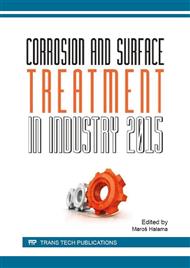[1]
X. -M. Li, Y. Han, Mechanical properties of Ti(C0. 7N0. 3) film produced by plasma electrolytic carbonitriding of Ti6Al4V alloy, Appl. Surf. Sci. 254 (2008) 6350-6357.
DOI: 10.1016/j.apsusc.2008.03.172
Google Scholar
[2]
Z. Hu, F. Xie, Y. Liu, X. Wu, Study of plasma electrolytic nitrocarburizing on surface of titanium alloy, Materials review (04) (2008). http: /en. cnki. com. cn/Article_en/CJFDTOTAL-CLDB200804037. htm.
Google Scholar
[3]
Y. -X. Dong, Y. -S. Chen, Q. Chen, B. Liu, Z. -X. Song, Characterization and blood compatibility of TiCxN1−x hard coating prepared by plasma electrolytic carbonitriding, Surf. Coat. Technol. 201 (2007) 8789-8795.
DOI: 10.1016/j.surfcoat.2007.05.097
Google Scholar
[4]
M. Aliofkhazraei, P. Taheri, A. Sabour Rouhaghdam, C. Dehghanian, Study of nanocrystalline plasma electrolytic carbonitriding for CP-Ti, Mater. Sc. 43(6) (2007) 791-799.
DOI: 10.1007/s11003-008-9024-z
Google Scholar
[5]
M. Aliofkhazraei, A. Sabour Rouhaghdam, Fabrication of TiC/WC ultra hard nanocomposite layers by plasma electrolysis and study of its characteristics, Surf. Coat. Technol. 205 (2010) S51-S56.
DOI: 10.1016/j.surfcoat.2010.04.010
Google Scholar
[6]
M. Kh. Aliev, A. Sabour, P. Taheri, Corrosion Protection Study of Nanocrystalline Plasma-Electrolytic Carbonitriding Process for CP-Ti, Prot. Met. Phys. Chem. Surf. 44(6) (2008) 618-623.
DOI: 10.1134/s0033173208060155
Google Scholar
[7]
M. Aliofkhazraei. A.S. Rouhaghdam, M. Sabour, Effect of frequency and duty cycle on corrosion behavior of pulsed nanocrystalline plasma electrolytic carbonitrided CP-Ti, J. Mater. Sci. 43 (2008) 1624-1629.
DOI: 10.1007/s10853-007-2323-1
Google Scholar
[8]
P.N. Belkin, I.G. Dyakov, A.V. Zhirov, S.A. Kusmanov, T.L. Mukhacheva, Effect of Compositions of Active Electrolytes on Properties of Anodic Carburization, Prot. Met. Phys. Chem. Surf. 46(6) (2010) 715-720.
DOI: 10.1134/s2070205110060158
Google Scholar
[9]
P.N. Belkin, E.A. Pasinkovskij, Heat treatment and case hardening of steels subjected to heat in electrolytic solutions, Met. Sci. Heat Treat. 31(5-6) (1989) 331-337.
DOI: 10.1007/bf00801655
Google Scholar
[10]
P. Belkin, B. Krit, I. Dyakov, V. Vostrikov, T. Mukhacheva, Anode saturation with nitrogen and carbon in aqueous solution of carbamide-bearing electrolytes, Met. Sci. Heat Treat. 52(1-2) (2010) 20-24.
DOI: 10.1007/s11041-010-9224-7
Google Scholar
[11]
E.P. Grishina, A.V. Zhirov, P.N. Belkin, A.I. Dikusar, Influence of anodic electrothermochemical oxidation of steel 45, Surf. Eng. Appl. Electrochem. 44 (2008) 390-395.
DOI: 10.3103/s1068375508050098
Google Scholar
[12]
S.A. Kusmanov, S. Yu. Shadrin, P.N. Belkin, Carbon transfer from aqueous electrolytes to steel by anode plasma electrolytic carburizing, Surf. Coat. Technol. 258 (2014) 727-733.
DOI: 10.1016/j.surfcoat.2014.08.005
Google Scholar
[13]
S. Yu. Shadrin, P.N. Belkin, Analysis of models for calculation of temperature of anode plasma electrolytic heating, Int. J. Heat Mass Transfer 55 (2012) 179-186.
DOI: 10.1016/j.ijheatmasstransfer.2011.09.001
Google Scholar
[14]
P.N. Belkin, A.M. Borisov, V.G. Vostrikov, I.G. Dyakov, E.A. Romanovskii, M.V. Serkov, Application of NBS protons for the study of anode chemical-heat treatment of titanium, Fisika i chimija obrabotki materialov (1) (2006) 59-61 (in Russian).
Google Scholar
[15]
S.A. Kusmanov, I.G. Dyakov, P.N. Belkin, L.A. Gracheva, V.S. Belkin, Plasma Electrolytic Modification of the VT1–0 Titanium Alloy Surface, Journal of Surface Investigation. X-ray, Synchrotron and Neutron Techniques 9(1) (2015) 98-104.
DOI: 10.1134/s1027451015010139
Google Scholar
[16]
V.E. Blashchuk, N.M. Kareta, L.M. Onoprienko, P.N. Belkin, E.A. Pasinkovski, Effect of Electrolytic Nitriding on the Corrosion Resistance of VT1-0 Commercial Titanium, Elektron. Obrab. Mater. (3) (1986) 20-22.
Google Scholar
[17]
P. Belkin, S. Kusmanov, A. Naumov, Yu. Parkaeva, Anodic Plasma Electrolytic Nitrocarburizing of Low-Carbon Steel, Adv. Mater. Res. 704 (2013) 31-36.
DOI: 10.4028/www.scientific.net/amr.704.31
Google Scholar


